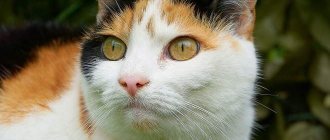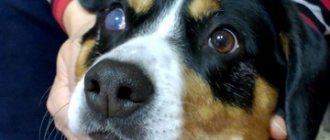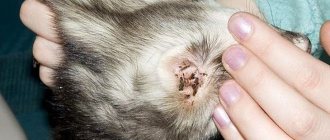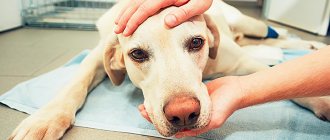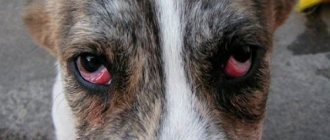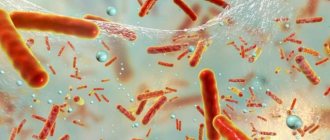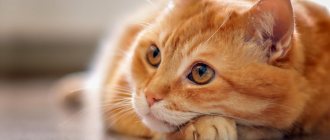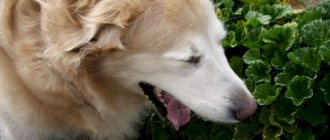You don't always have to worry if your cat has a black nose. The color of a cat's nose always depends on the color of its coat; animals are black and their nose will be black by nature. White cats also have a white or pink nose, red cats have an orange nose, motley animals can even boast mottled or freckled ones. But a change in the color of the nose or the appearance of black crusts or spots on it is always an alarming symptom. If your cat's nose suddenly turns black, this is a reason to contact a veterinarian as soon as possible.
The main causes of nasal discharge in cats
Many feline diseases cause rhinitis. Infections that enter the animal's body cause an inflammatory process in the mucous membrane of the nasal passages. One of the most common types of discharge is clear discharge from a cat’s nose, which can be a consequence of the following negative factors:
- Hot air. A clear liquid very often appears on the nose of cats during the summer. Dry and hot air provokes wetting of the organ. In this case, no treatment is required. If the owner discovers any additional signs of the pet’s serious condition, it is recommended to consult a specialist. Perhaps the cat has an imbalance of vitamins, or there is a hormonal imbalance. After passing the tests, the veterinarian will draw conclusions and recommend adjusting the diet, or prescribing a course of vitamins and hormonal drugs;
- The presence of foreign irritants in the air. These include plant pollen, smoke, and dust. Cats, like people, can have an allergic reaction to flowering plants, both at home and outdoors. Owners often notice that cats sneeze, snot and tears come out. These are clear signs of an allergy to plants, dust, or smoke floating in the air. To alleviate the animal’s condition, it is recommended to give the pet anti-allergy medications prescribed by a veterinarian, as well as remove allergy-provoking substances from the room, carry out wet cleaning and ventilate the room;
- Virus. In severe cases, the owner of the four-legged dog observes purulent discharge from the cat’s nose. This is a clear sign of an infection or virus that has entered the organ cavity. In this case, antiviral drugs are required. When the body is severely damaged, the pet becomes lethargic, its body temperature rises, it refuses to eat, it sneezes, and it coughs. In this condition, it is necessary to begin antibiotic therapy.
Treatment of mucous and transparent discharged masses and the nasal cavity in cats is carried out only after an accurate determination of the cause of the phenomenon. To alleviate the pet's condition and reduce irritation of the skin of the nose, it is recommended to lubricate the surface with an emollient ointment, such as Oxolinic or Tetracycline. To reduce fever in very furry pets, it is recommended to cut off a few centimeters of fur. If the doctor has determined the presence of serous rhinitis, in which purulent discharge is observed, then nasal drops, such as Anandin, Fosprenil, are prescribed. In case of an allergic reaction, the cat is prescribed antihistamines to block it. One of the most effective is Diphenhydramine in the amount of half a tablet per day for three days. If treatment at home does not give positive results, then you need to show your pet to a specialist and undergo diagnostics.
Symptomatic treatment
If nasal discharge interferes with the animal’s full life, increases and changes in composition, then the cat must be shown to a doctor.
The veterinarian will assess the animal's condition. To make a more accurate diagnosis, the specialist will assess the cat’s general condition and well-being. He will also appreciate:
- the nature of the discharge (when it is more frequent, when, on the contrary, there is practically no discharge, whether the intensity of the discharge is affected by the activity of the animal, in what position of the body the flow from the nose is especially strong);
- abundance of discharge;
- does the discharge dry out and form crusts, or does the nose remain wet most of the time;
- is there snoring, sniffling, how much does the cat’s discharge bother him?
- where the discharge is localized: in both nostrils or only in one;
- Does the cat breathe through its nose while sleeping?
- how much the animal’s behavior changed when a runny nose appeared.
In accordance with the diagnosis, the specialist will prescribe treatment. It is important not to self-medicate and follow the doctor’s recommendations. It is also necessary to properly care for the animal’s sore nose, clean it of mucus, pus and crusts as carefully as possible so as not to damage the nasal passages.
So, in case of allergic reactions, it is not necessary to clean your nose of clear mucus. Veterinarians prescribe antihistamines, but they will only be effective if the allergen has been eliminated.
For rhinitis, the nose is washed with a 1% zinc sulfate solution or saline solution. You can warm your nose with bags of cereal heated in a frying pan.
For infections, it is important to correctly identify the pathogen and select the appropriate antibacterial, antiviral or antifungal drug. As a rule, relief occurs after 2-3 uses of the medicine.
If the animal’s nose is stuffy and it’s hard for him to breathe, then vasoconstrictor drops are used. But you should not abuse them - such drops are addictive. Drops are selected in children's dosage.
For tumors and polyps, doctors consider surgery. It is important to assess the depth of the tumor, the general condition of the animal, and concomitant diseases.
But it is worth remembering that if a foreign body gets into the cat’s nose, you cannot remove it yourself using cotton swabs or tweezers. This can push the object even deeper into the nostril and injure the mucous membrane!
Mucous nasal exudate in cats
It is very important to understand what breed the pet living in the house is. This information is necessary because in some cat breeds, mucoid exudation from the nasal passages is a normal physiological condition. Mucus can also appear as a result of such negative factors as:
- hot and too dry indoor air;
- dust or smoke in the room;
- respiratory tract infections;
- severe hypothermia of the body, especially in winter;
- weakened immune system;
- catarrhal rhinitis, which for many cats is a consequence of an allergic reaction.
Treatment directly depends on the cause of the disease. In severe situations, it is very important to carefully shave the hair around the nose to prevent the passages from sticking from mucous masses. Dark nasal discharge in a cat indicates the presence of blood or pus. Mucus can appear against the background of injury to the organ, for example during a fight with relatives or after a fall from a height. In this situation, the injured mucous membrane begins to bleed and dark exudate appears. A similar phenomenon can occur against the background of purulent discharge. To treat scratches inside the organ cavity, the body begins to secrete many leukocytes, which are localized at the site of the cuts to eliminate microbes. After their death, pus is formed, flowing from the nasal passages.
Treatment is prescribed by a veterinarian after determining the cause of the phenomenon. In mild situations, self-therapy at home is allowed.
Infections
Your cat's ears are going bald: causes of baldness and treatment options
Black crusts on the nose of cats, along with purulent discharge, can be symptoms of infectious diseases. To successfully treat an infection, you should first undergo tests (skin scraping and nasal swab) to determine the nature of the disease. In case of infection, the affected areas are treated with chlorhexidine (Miramistin) and lubricated with levomekol or other antibacterial agents as recommended by a doctor.
The color of a cat's nose always matches the color of its coat.
Important! If left untreated, infectious diseases can lead to complications or even death of the animal.
We should not forget that the health of mustachioed babies, like any children, is more fragile than that of adult animals, so a kitten’s dirty, crusty nose requires immediate action and timely treatment.
You should pay special attention to the health of kittens
Purulent nasal discharge in a cat is a possible cause of the pathology.
The development of rhinitis in cats is a kind of protective reaction of the body, aimed at quickly ridding the nasal passages of possible allergens or pathogenic microorganisms.
Discharge of exudate from the nasal passages is often accompanied by sneezing and difficulty breathing. The pet tries to open its mouth in order to inhale more air, while the mucous membrane of the oral cavity begins to dry out, adding new discomfort to the animal.
Purulent rhinitis in cats is diagnosed quite often and can be evidence of an infectious disease or a sign of a pathological process that develops as a result of a congenital anomaly.
The appearance of pus from the nasal passages of a pet is a reason to immediately seek help from a veterinarian. This will prevent serious complications that can threaten not only the health, but also the life of the cat.
Possible diseases characterized by purulent nasal discharge
Purulent nasal discharge in a cat is not the main disease, but only a signal from the body about the development of pathology.
Purulent exudate is not only unpleasant in appearance and has a repulsive odor, but also seriously impairs breathing and can also interfere with the act of swallowing.
Veterinary specialists often diagnose the appearance of pus from the nose associated with an infection that has caused an inflammatory process in the middle ear or eustachian tube.
Pus may appear from the nose of a pet due to malignant neoplasms in the nasal passages. Pus is diagnosed in the last stages of lymphosarcoma, fibroxarcoma, osteosarcoma, adenocarcinoma. In addition, the causes of pus from a cat’s nose can be:
- injuries to the back of the nose and nasal passages of the mechanical type (due to impacts or a stuck foreign body in the upper part of the respiratory tract);
- abnormalities of intrauterine development (cleft palate or cleft lip, deviated nasal septum);
- infectious diseases (viral infections);
- toxoplasmosis and chlamydial pneumonia.
In the vast majority of clinical cases with viral respiratory infections, not only nasal discharge is observed. For example, with a herpes virus infection, discharge from the eyes and nose in cats is observed. Statistics say that 85% of all reported cases of purulent exudate from the nasal passages are due to a cat becoming infected with a calcivirus infection. Feline viral rhinotracheitis can damage the upper respiratory tract, as well as the eyes and mouth. The symptoms of the disease are unusually similar to the influenza virus, since with calcivirus, dyspeptic disorders and pulmonary dysfunction develop. Kittens and cats without immunization are susceptible to infection. At risk are cats with viral immunodeficiency and feline leukemia, as well as pets with chronic diseases of internal organs.
Another dangerous disease that affects the cat’s body is cryptococcosis. This is an infection caused by fungal microorganisms found in the environment. It is characterized by damage to the upper part of the respiratory tract, inflammatory processes in the area of the pulmonary structures and the labyrinth of the nose. It is possible for a fungal infection to spread to the eye area, under the skin and penetration into the central brain. Fortunately for owners, cryptococcosis is diagnosed less often in cats than in other domestic animals.
In cats of the British breed and Scottish Fold, structural pathologies in the form of stenosis of the nostrils are often diagnosed. A congenital anomaly is the cleft lip, which is one of the factors in the occurrence of purulent discharge from the nasal passages. The causes of purulent discharge are toxoplasmosis and chlamydia in the acute stage of the course. Chlamydial infection can be transmitted through discharge from a sick animal to a healthy one. Transmission of the pathogen is also possible through contact of an animal with feces or urine of a sick cat. Pregnant cats can transmit chlamydia to unborn kittens when they pass through the birth canal. In addition to rhinitis, chlamydia leads to serious damage to the mucous membrane of the eyes and conjunctival sac. The organs of the respiratory system, digestive tract and urinary system are affected.
Alarming symptoms: what to look for?
The animal's condition may be complicated by the formation of crusts in the problem area.
If a pet's nose has turned black and various spots have formed, then the owner should not ignore this condition. When the disease is advanced, the spots spread throughout the cat’s body and lead to dangerous complications. Additionally, the cat is disturbed by the following unpleasant symptoms:
- swelling and redness of the skin;
- hair loss in the area where the spots formed;
- inflammatory reaction of the epidermis;
- multiple small pimples;
- itchy sensations;
- deterioration of the coat condition;
- peels of different colors;
- dry nose.
Diagnosis and treatment
The appearance of purulent discharge in a pet means that the owner should immediately contact a veterinary clinic. It is not recommended to prescribe treatment on your own, since without specific diagnostic methods, feasible only in a hospital setting, it is not possible to prescribe adequate therapy. At an appointment with a veterinarian, the animal undergoes a clinical examination and laboratory tests. The basis of diagnosis is the determination of the qualitative composition of the exudate. Cytology can identify a fungal infection or viral agents. A sample of purulent discharge is also taken for analysis and further bacterial culture. After identifying the causative agent of the disease, the specialist draws up an individual treatment regimen.
If there is a suspicion of a foreign body stuck in the nasal passages, a neoplasm, or a deviated septum as a result of injury, ultrasound diagnostics of the cat's nasal sinuses and radiography are performed. Only after receiving all the test results, conservative or surgical treatment is prescribed.
To soften the resulting purulent crusts and exudate, it is necessary to rinse the nasal passages. Cotton pads soaked in natural vegetable oil are used. You can soak dried crusts using saline or a solution of boric acid.
For viral infections, mandatory antiviral therapy using vaccines is necessary. The presence of a fungal infection includes the use of systemic antifungal agents in the course of therapeutic measures. Pathogenic bacterial microflora, sown when taking a smear, implies the use of systemic antibiotics. A cat with purulent rhinitis is given immunostimulating drugs to strengthen the body's defenses to independently fight the disease.
In case of pronounced anomalies or injuries of the nasal passages, accompanied by purulent discharge, surgical manipulations are necessary. This allows you to eliminate pathology and make your pet’s life easier.
Prevention
Preventive measures to prevent the development of purulent rhinitis involve regular examinations by veterinary specialists. This allows you to promptly identify possible anomalies in the structure of the nasal septum or other pathologies. At the slightest sign of your pet's ill health, you should contact a veterinarian for advice.
The development of dangerous viral diseases accompanied by profuse purulent discharge from the nose can be prevented by timely immunization of the cat. The necessary criterion is proper nutrition and maintaining the body’s defenses at the proper level.
Discharge from the eyes
The discharge is usually clear or has a brownish tint, accompanied by a reddish/brown coloration of the cat's eyes, and the eyes may also become watery. The reasons for the appearance of discharge can be different: impaired outflow of tears, foreign objects in the eye, epiphora, blepharitis, etc. Discharge can also be a consequence of poor nutrition - for example, mixing natural food with feed or feed from different manufacturers in the diet.
Infrequent discharge from your pet's eyes is normal. But you should still wash your cat's eyes periodically.
Treatment and prevention of eye discharge
In order for the discharge to stop, its cause must be identified and eliminated. To cleanse the eyes, you can rinse with warm clean water, tea, chamomile decoction, saline solution or boric acid solution (add 2 teaspoons to ½ glass of water).
To carry out the rinsing procedure, you may need the help of another person to hold the pet while you drip the solution. Prepare a tampon in advance by twisting cotton wool into a rope. It is better to avoid using cotton swabs, because... they can injure the animal's eye). After soaking the swab in the solution, squeeze it onto the cat's eyeball. If your pet's eyelids are glued together, then the solution is applied directly to their surface: after a while, the eyelids will open, which will allow you to proceed to rinsing the eye. If your cat's eyelashes are stuck together, run a cotton swab over their surface, moving towards the corners of the eyes. If the eyelashes do not fall apart immediately, repeat the procedure until you can rinse the eye itself.
If the discharge appears due to infection, then the cat should be shown to a veterinarian as soon as possible. Rinse your animal's eyes only with a warm solution (not hot, but not cold either). Be careful not to let the dry swab or cloth come into contact with the surface of the eye, as the material may stick to it, causing damage. When washing and wiping your eyes, change swabs as often as possible.
The veterinarian may prescribe eye drops to treat the animal. To instill the medicine, turn your pet's head so that the eyes are looking up. Place your hand with a pipette or cotton swab dipped in liquid 1-2 cm from the cat's eye, and then start dripping 1-2 drops.
The eye ointment should be squeezed into the corner of the eye, slightly pulling the lower eyelid. Before doing this, it is better to warm the ointment to room temperature so that it gets into the eye more easily.
You shouldn’t wait until your pet starts to have discharge from the eyes - rinse them as a preventative measure. It is especially important to care for the eyes of a cat that is often outdoors, as dust particles and fingers can get into them.
Pet treatment
If your cat's nose begins to turn black, you should not self-medicate or waste time. Without special education, it is impossible to establish the exact reason why the nose turned black or discharge began. And not only the pet’s health, but also its life often depends on a timely visit to the veterinarian. It is useful to always have in your phone the contacts of a good veterinary clinic that is open 24 hours a day. One day this could save a pet's life.
Only a veterinarian can correctly diagnose and prescribe treatment for a cat.
Important! It should be remembered that water is much more important than food. The animal will live no more than two days without water, so you need to carefully monitor the pet and, if necessary, forcefully water it from a syringe, after immobilizing its paws.
Nasal discharge
A cat's nose cleans the inhaled air of dust and other contaminants. But in addition to air, the animal can inhale pathogenic bacteria and viruses. The nose filters them out, preventing them from entering the body. Dust and microbes settle on the mucous membrane, forming dark thin crusts. They are released through the nose while washing. Such discharge is not a sign of illness, but a normal phenomenon for the animal.
A cat can also inhale a foreign body - an insect, a small bone, a thread, etc. In this case, he begins to sneeze, as a result of which the foreign particle comes out of the nose on its own. If the foreign object does not come out, under no circumstances try to remove it yourself (you can seriously damage the mucous membrane), but show the cat to a veterinarian.
Copious nasal discharge, accompanied by sneezing and heavy breathing, indicates a serious illness in the cat, because pathogens of incurable diseases - leukemia and peritonitis - can enter the animal’s body through the nose. Only timely vaccinations can protect a pet from them.
Care
Before the doctor arrives, the animal should be provided with complete rest. The nose should not be completely cleared of pus so as not to complicate the diagnosis. Excessive heat before the doctor arrives is also not recommended, as this can increase inflammation. After receiving a diagnosis, you should strictly follow all the veterinarian’s instructions for care, treatment and feeding, without skipping procedures.
In addition to direct treatment, a sick animal also needs the care and attention of its owner. You need to find time not only for medical procedures, but also for affectionate communication with your pet. You should also monitor the cleanliness of the animal’s fur, since due to weakness, most likely the cat will not have the strength to maintain it in proper form, and he will be very grateful to the owner for timely combing and cleansing the fur from pus, secretions or food debris.
For a sick animal, the care and attention of the owner is very important
If a cat has a black spot on its nose or any discharge from the nose or eyes, this is always a cause for concern. It should be remembered that people are responsible for those they have tamed. And the owner’s attentive attitude towards his pet is a guarantee of the animal’s health and longevity.
Watery discharge from the nasal passages
One of the most common types of nasal discharge is watery nasal discharge. And they are not always a sign of pathological conditions:
- The discharge of “water” from the nose may be the body’s reaction to heat, stuffiness and too dry air.
- In addition, a “waterfall” from the nasal passages often occurs when there is too much dust, pollen, smoke, etc. in the air in the room. This is how the body tries to prevent large amounts of debris from entering the upper respiratory tract.
But still, in many cases, constant discharge that increases over time is a serous exudate that appears in the first stages of the inflammatory process and/or allergies. Subsequently, it can “mutate”, turning into catarrhal (mucous) or purulent exudate. The main reason for its appearance is viral and bacterial infections of various etiologies.
Treatment
Treatment always depends on the root cause of the discharge, but the general recommendations in all cases are quite standard:
- To prevent the constantly flowing exudate from contributing to maceration (softening) of the skin around the nose, it is lubricated with something like oxolinic or tetracycline ointment.
- We recommend that hair that is too long (especially if the pet is particularly shaggy) be cut off in advance. This will greatly facilitate the treatment process.
- As a rule, serous rhinitis (but not always the reasons that caused it) can be treated with medicinal drops like Anandin or Fosprenil.
- If the discharge is a consequence of an allergy, the animal is given ½ tablet of diphenhydramine per day, but no more than three days in a row. In cases where it is not possible to stop the allergic reaction within this period, it is necessary to contact a veterinarian.
Allergic rhinitis in cats
If you observe watery discharge accompanied by sneezing, it usually means your cat has ingested or inhaled an allergen from the environment. Allergies to non-food irritants, also known as atopy, were most likely inherited by your cat from her parents.
Note! Atopic allergy is an increased sensitivity to common allergens: plants and their waste products, mold, insect bites and dust mites, etc.
Mucous discharge from the nose
As in the previous case, mucous discharge from the nose is common in veterinary practice. And, as in the previous situation, their presence does not always indicate some kind of disease:
- Very often, mucous discharge appears in cases where the air that the animal breathes is heavily dusty and gassed. In this situation, mucus acts as a natural “fine filter”, preventing dirt from passing further.
- Mucus is a natural secretion of the mucous membranes, and in some breeds of animals there is especially a lot of it. The latter category, for example, includes bulldogs and similar dog breeds.
But in other cases, thick and abundant mucus is almost certainly a sign of some kind of pathology:
- This is how many bacterial or viral (less commonly) infections of the upper respiratory system manifest themselves.
- Catarrhal rhinitis is characteristic of many cases of chronic allergies.
- The classic cause of the appearance of mucous exudate can be considered severe hypothermia.
- The secretion of large quantities of mucus is typical when animals inhale caustic and irritating substances. In these situations, the body seeks to mitigate the consequences and prevent erosion of the mucous membranes.
- Systemic pathologies. This includes almost all diseases that in one way or another weaken the pet’s immunity.
Treatment methods
As in the previous case, the specific therapeutic method will depend entirely on the root cause of the disease identified by the veterinarian. But even in this situation, general recommendations still need to be given:
- It is necessary to carefully cut off all the thick hair near the nasal passages to prevent mucous secretions from sticking and drying out with the subsequent formation of scabs and crusts.
- If numerous “bugs” prevent the cat from breathing normally, they must be removed in a timely manner. For this purpose, we recommend using regular cotton pads soaked in warm and sterile saline solution. It is necessary to carefully wipe the exudate from the skin around the nose and, if possible, try to remove its accumulations from the nasal passages. If the animal is large enough, then the same saline solution (necessarily warm) filled into the smallest syringe can be used to wash out the mucus from the nose. There is no need to press hard on the syringe!
- To relieve inflammation, you can also use Maxidin, Fosprenil and Anandin.
Purulent discharge from the nasal passages
Unlike both cases described above, the appearance of pus cannot be explained by physiological reasons. If purulent exudate is released from the cat’s nose, this always indicates the presence of an inflammatory process. The latter may be due to the following reasons:
- The main predisposing factor is always the development of pyogenic microflora in the nasal cavity or in other upper parts of the respiratory system.
- Accordingly, purulent rhinitis is a common consequence of systemic and local infections of bacterial etiology.
- Often accompanied by purulent inflammation, the entry of foreign bodies into the nasal cavity. Their surface almost always contains pathogenic and conditionally pathogenic microflora, so inflammation develops very quickly.
- For the same reasons, pus in the nose can be the result of injury. The mucous membranes are damaged and can no longer serve as a barrier to infection.
- The most dangerous cause of pus is fungal infections of the nasal cavity.
Treatment
Since purulent rhinitis is always a consequence of bacterial contamination of the nasal mucous membranes, a standard treatment regimen is used:
- Broad-spectrum antibiotics are always prescribed. In recent years, drugs from the cephalosporin group are usually used for this purpose. In addition, other antimicrobial drugs may be prescribed.
- It is very advisable to rinse the cat’s nose up to four times a day with a hypertonic solution of table salt, since otherwise the exudate will dry out in the nostrils, preventing the animal from breathing normally.
- The food of a sick animal should have an increased content of vitamins A and E, which promote accelerated regeneration of mucous membranes, as well as zinc (for the same purpose).
- All fur around the nose must be cut off, and any exudate that is released must be removed from the cat’s face as it appears. If this is not done, the skin around the nose will quickly become soft and inflamed (pus is a powerful natural solvent).
Injuries
The cat's nose is a very sensitive and delicate organ; it is naturally constantly moisturized, for this reason its damaged skin takes a long time to heal. If there is no doubt that the cause of the appearance of black crusts on the nose is an injury, then the cat will not require special treatment. After the damaged tissue is restored, the crust will fall off on its own. Only if weeping wounds or ulcers appear, the nose should be treated with an antiseptic.
Black cats will always have black noses too.
